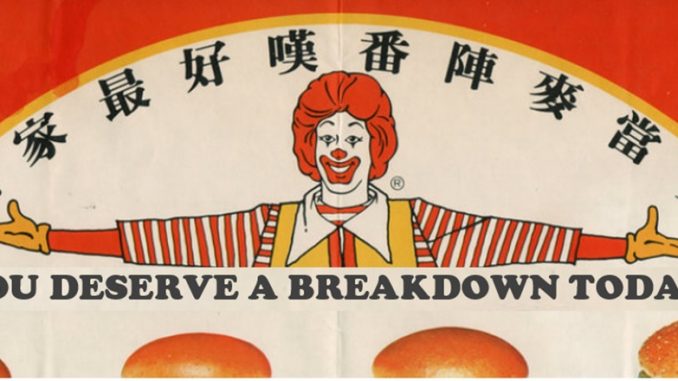
by Andrew Kliman
AHORA EN ESPAÑOL: A. Sebastián Hdez. Solorza’s translation of this article and the accompanying interactive spreadsheet [Editor’s Note, Nov. 7, 2021]
[Editor’s Note, Dec. 13, 2021] PODCAST EPISODES ON THIS ARTICLE:
Kliman responds to 15 challenges to and questions about this article [Editor’s Note, Jan. 27, 2022]
INTERACTIVE SPREADSHEET FILE: The Bauer-Grossmann reproduction scheme once rising productivity cheapens commodities
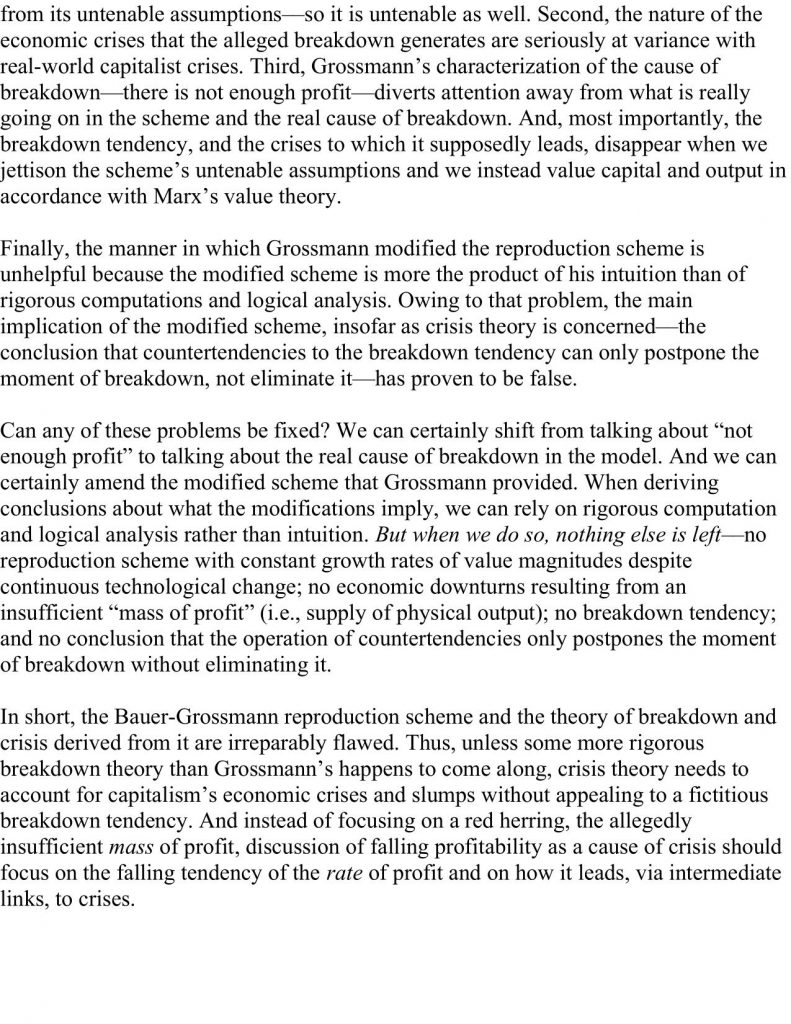
Bauer, Otto. 2012. The Accumulation of Capital. In Richard B. Day and Daniel Gaido (eds.), Discovering Imperialism: Social Democracy to World War I, pp. 719–43. Leiden and Boston: Brill.
Clarke, Simon. 1989. The Marxist Theory of Overaccumulation and Crisis. CSE Conference paper. Available at https://homepages.warwick.ac.uk/~syrbe/pubs/CSECONF1989.pdf .
Duménil, Gérard and Dominique Lévy. 2000. The Conservation of Value: A rejoinder to Alan Freeman, Review of Radical Political Economics 32.1, pp. 119–46.
Grossmann, Henryk. 1992. The Law of Accumulation and Breakdown of the Capitalist System: Being also a theory of crises. Translated and abridged by Jairus Banaji. London: Pluto Press.
Howard, M. C. and J. E. King. 1989. A History of Marxian Economics: Volume I, 1883–1929. Princeton, NJ: Princeton Univ. Press.
Kliman, Andrew. 2007. Reclaiming Marx’s “Capital”: A Refutation of the Myth of Inconsistency. Lanham, MD: Lexington Books.
–––––––. 2012. The Failure of Capitalist Production: Underlying Causes of the Great Recession. London: Pluto Books.
_______. 2016-17. All Value-Form, No Value Substance, Parts 1–13, With Sober Senses. Available at https://marxisthumanistinitiative.org/category/miscellaneous .
Kliman, Andrew, Alan Freeman, Nick Potts, Alexey Gusev, and Brendan Cooney. 2013. The Unmaking of Marx’s Capital: Heinrich’s Attempt to Eliminate Marx’s Crisis Theory. https://papers.ssrn.com/sol3/papers.cfm?abstract_id=2294134 .
Kuhn, Rick. 2004. Economic Crisis and Socialist Revolution: Henryk Grossman’s Law of accumulation, Its First Critics and His Responses, Research in Political Economy 21, pp. 181–221. Available at https://openresearch-repository.anu.edu.au/bitstream/1885/48485/3/kuhn_crisis_rev_postprint.pdf .
Mandel, Ernest. 1991. Introduction. In Marx, Karl, Capital: A Critique of Political Economy, Vol. III, pp. 1–90. London: Penguin Books.
Marx, Karl. 1989. Karl Marx, Frederick Engels: Collected Works, Vol. 32. New York: International Publishers.
–––––––. 1990. Capital: A Critique of Political Economy, Vol. I. London: Penguin Books.
–––––––. 1991. Capital: A Critique of Political Economy, Vol. III, pp. 1–90. London: Penguin Books.
Roberts, Michael. 2012. Crisis or Breakdown? https://thenextrecession.wordpress.com/2012/09/12/crisis-or-breakdown/ .
Satia, Priya. 2020. We All Think History Will Be on Our Side. Here’s Why We Shouldn’t Rely on That Assumption, Time magazine, Oct. 20. https://time.com/5901461/historical-judgment/ .

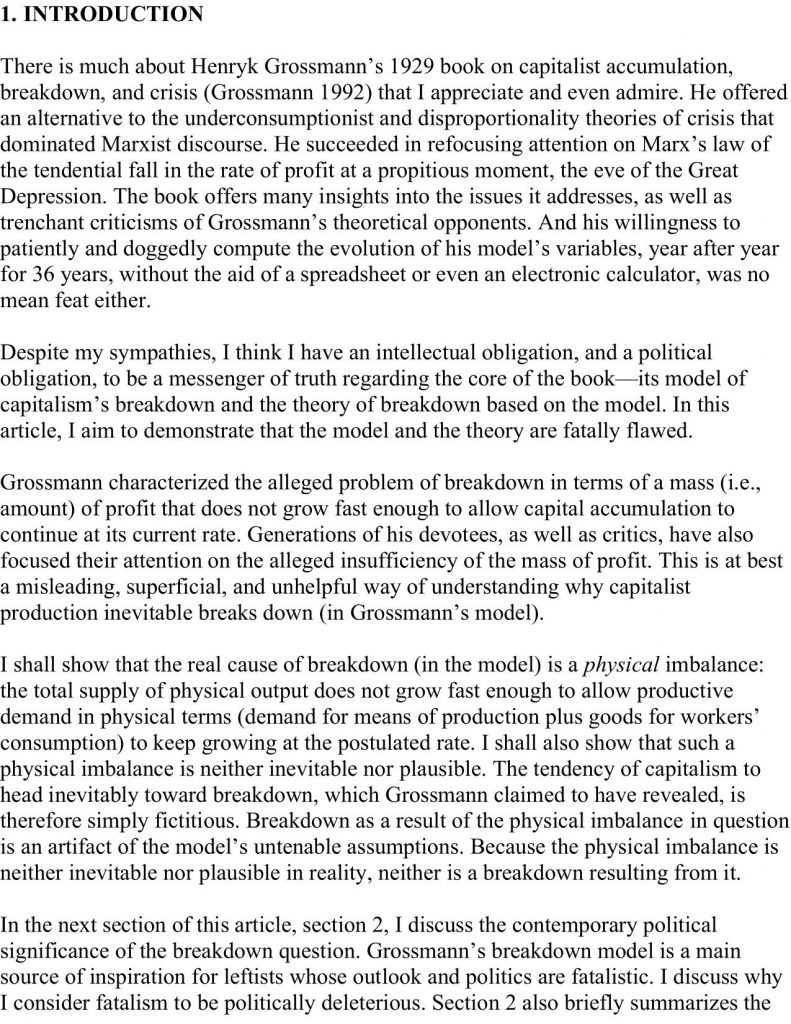
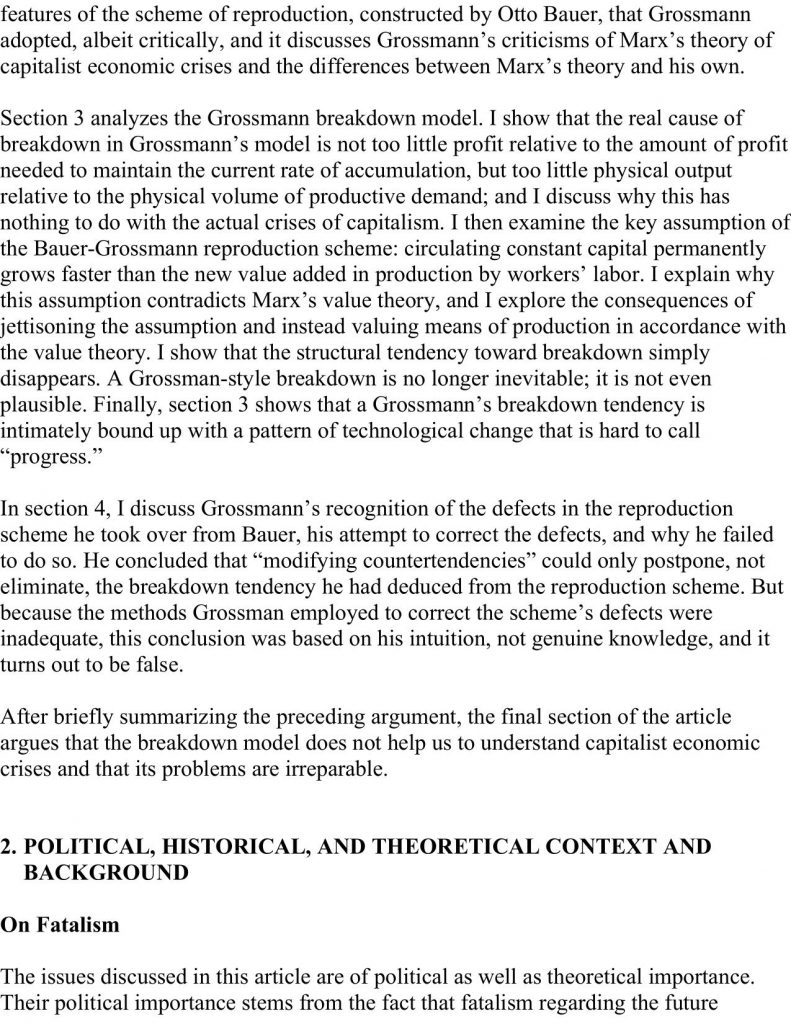
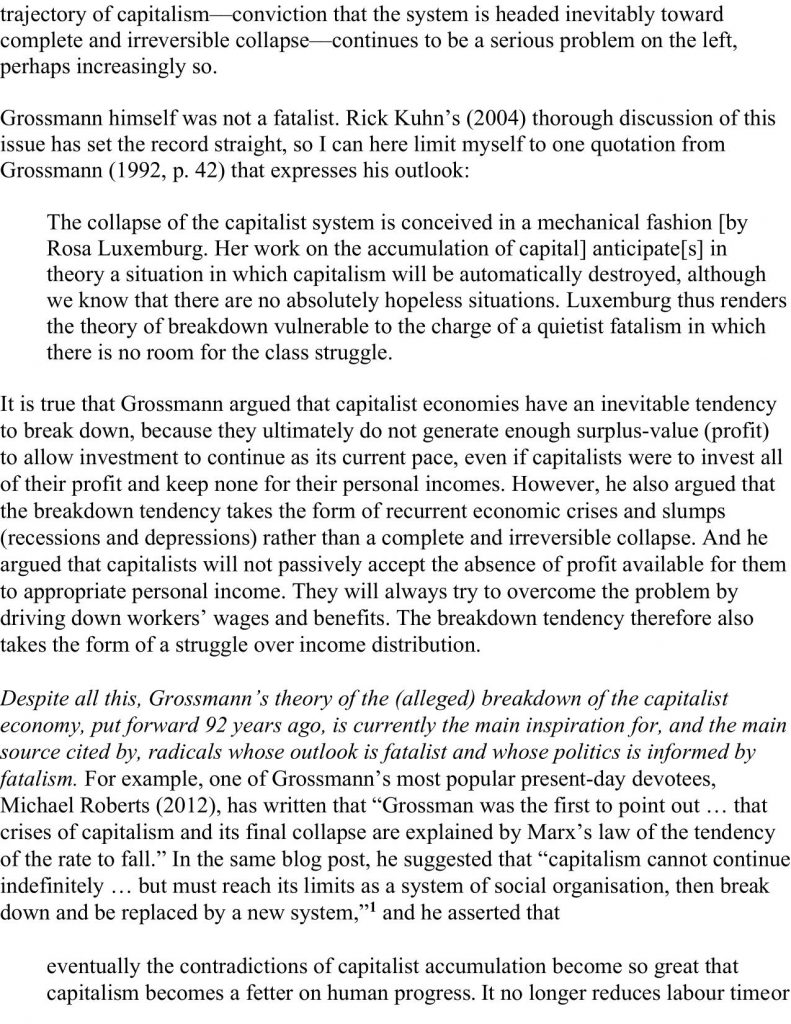
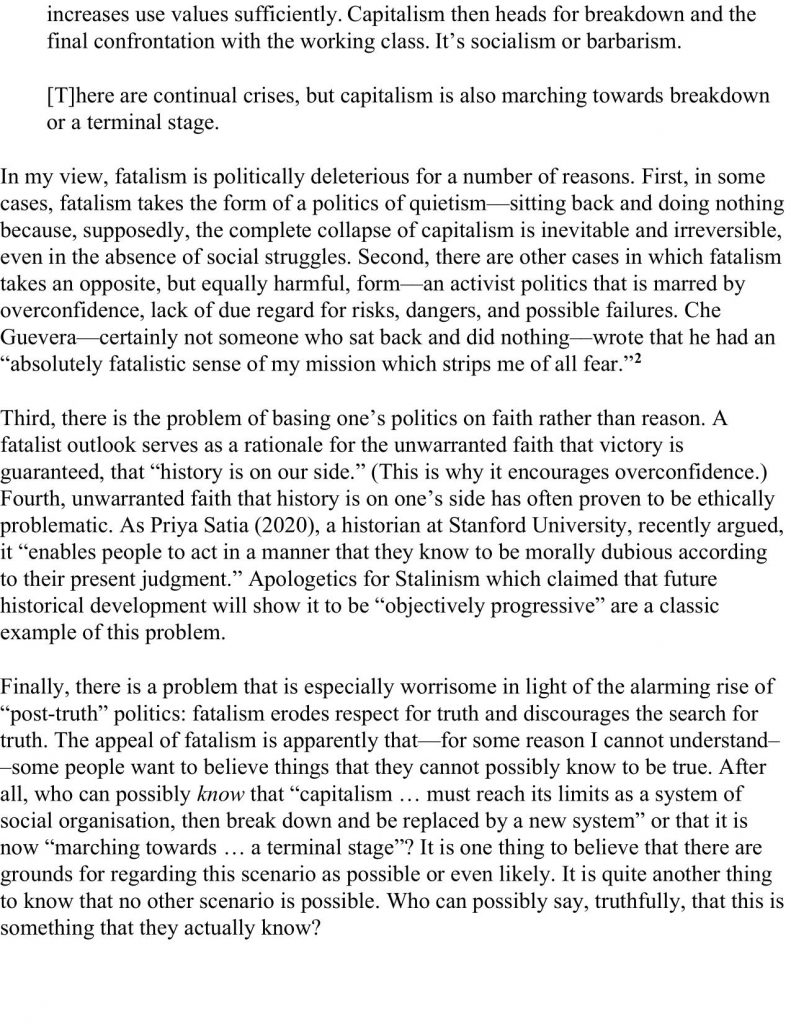
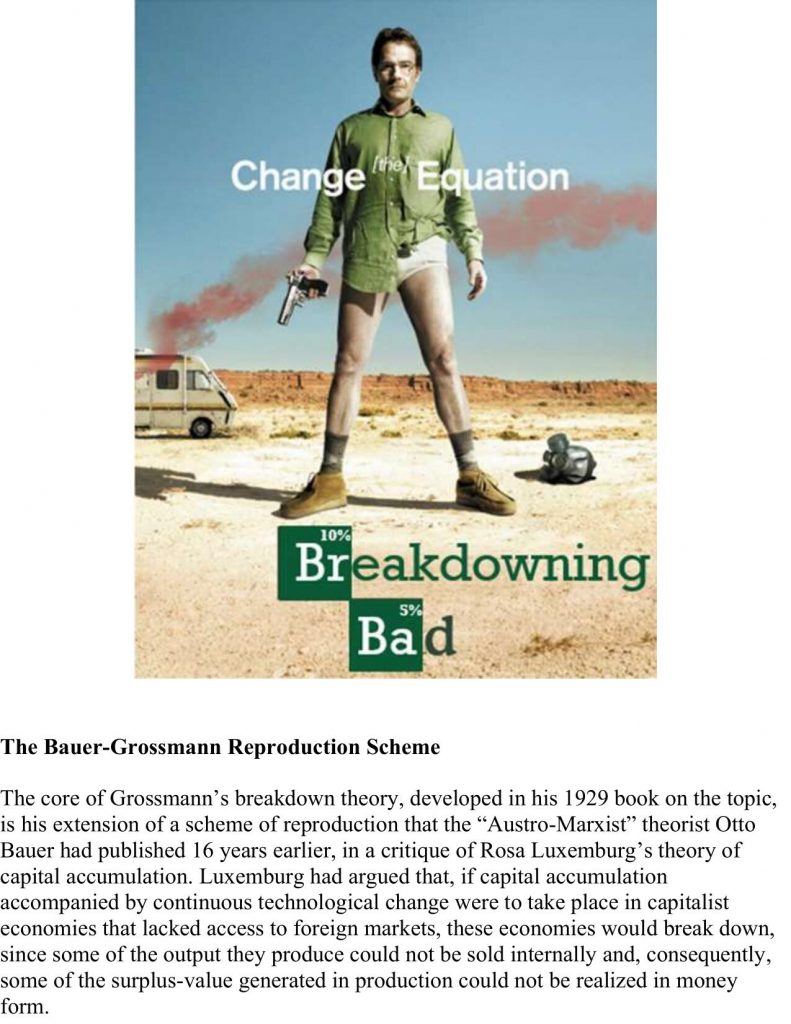
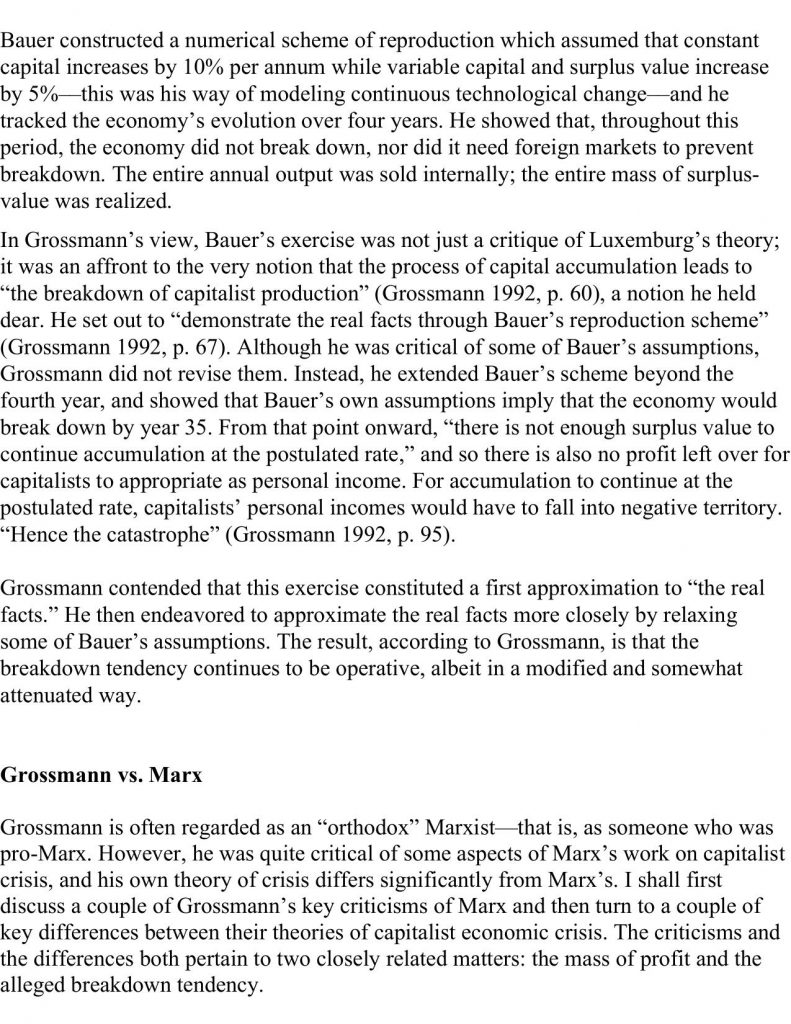
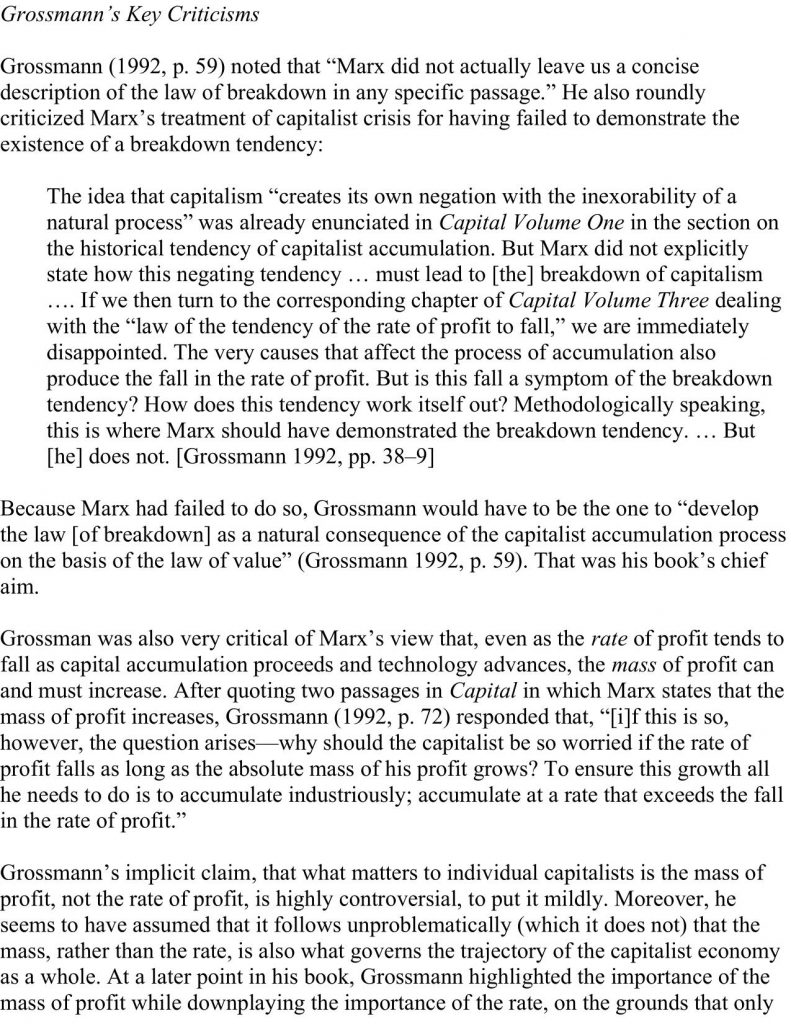
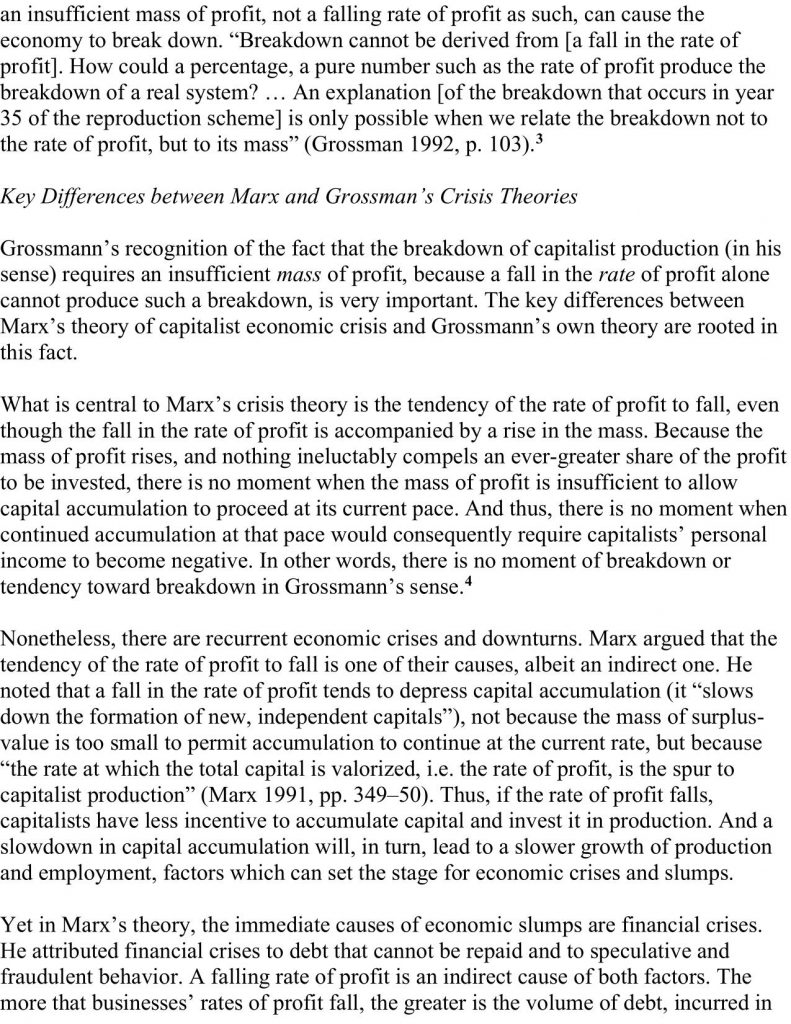
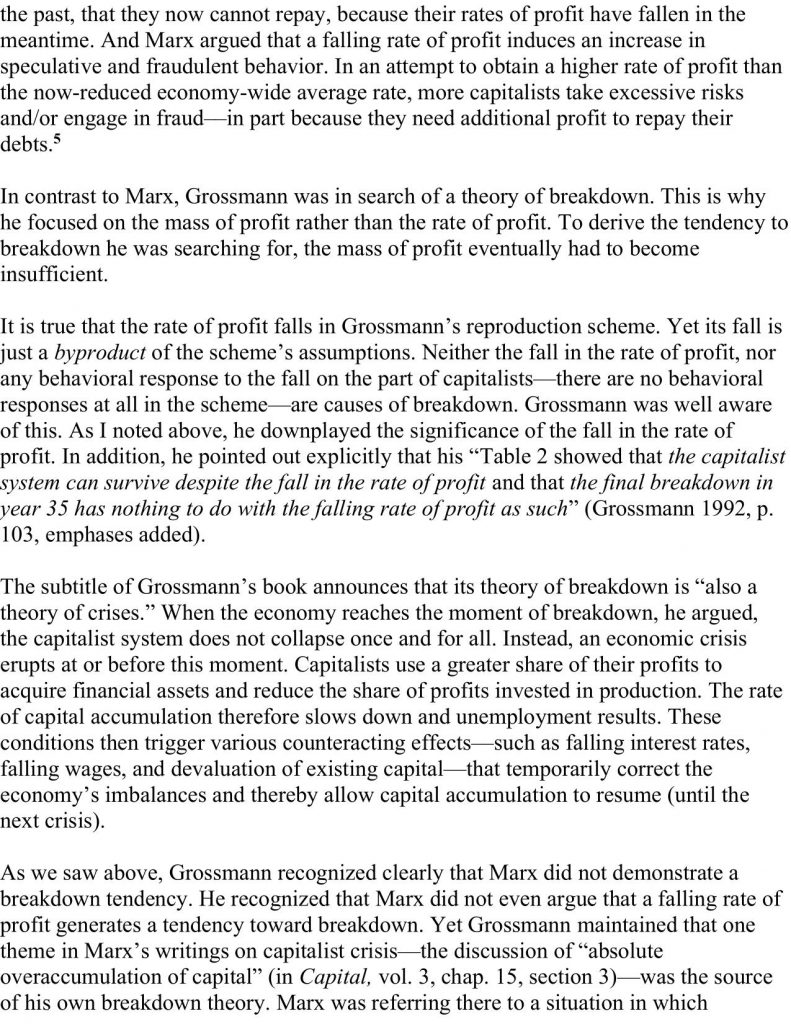
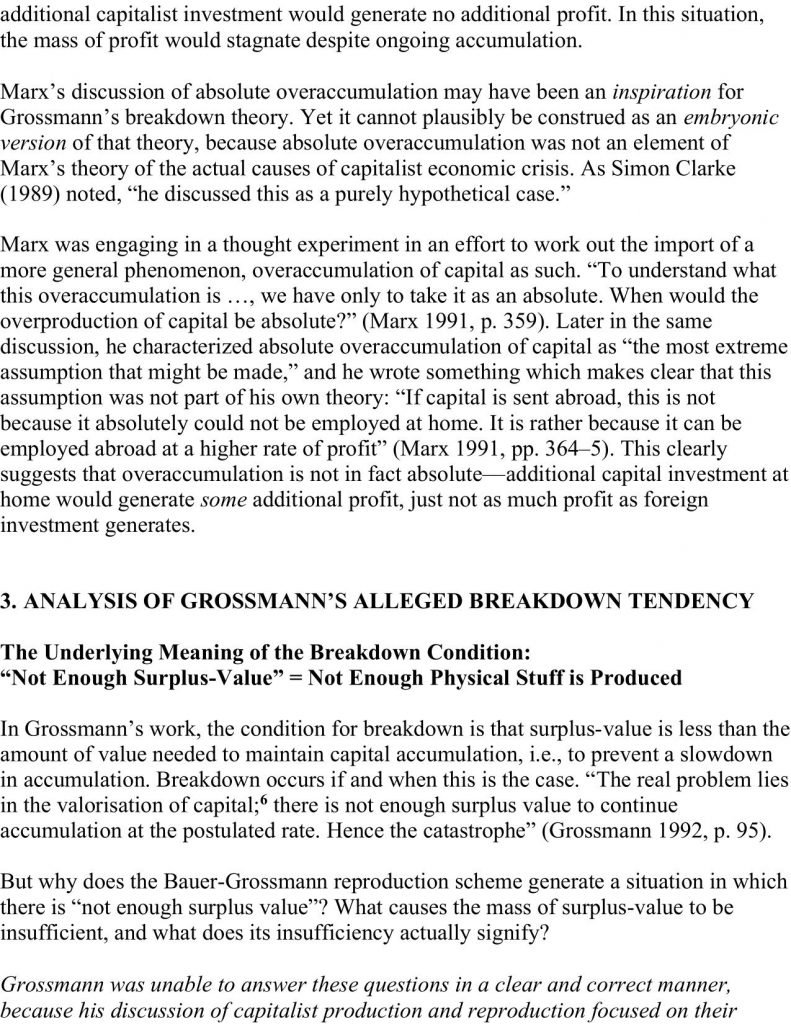
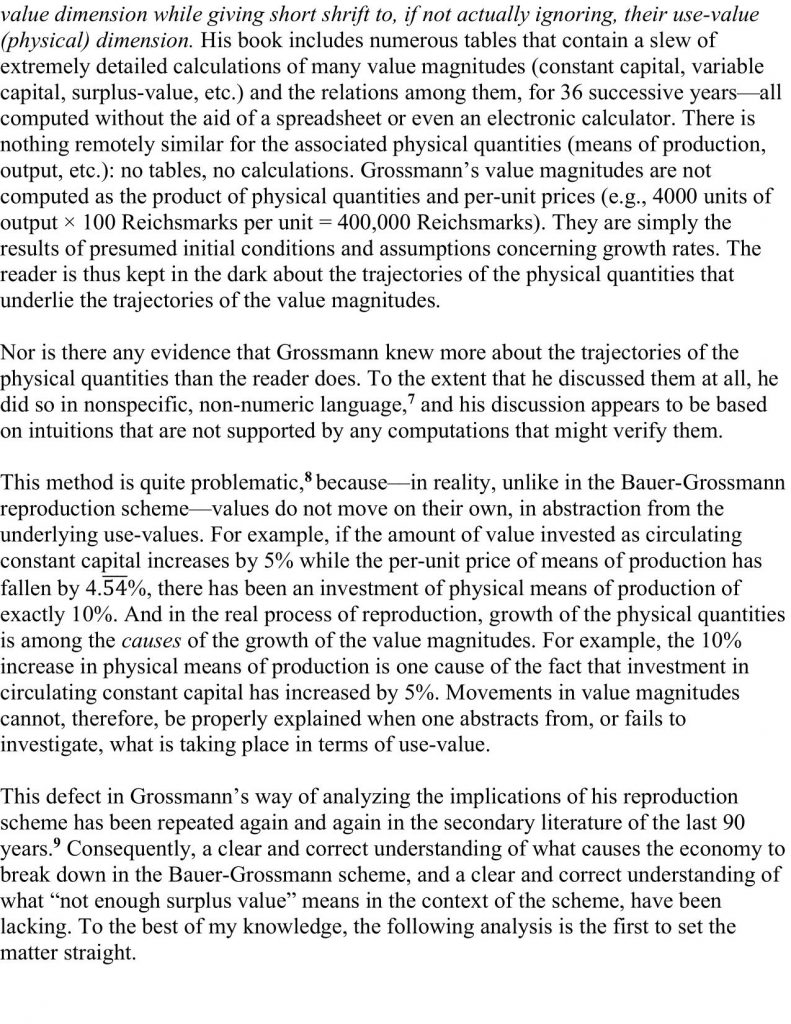
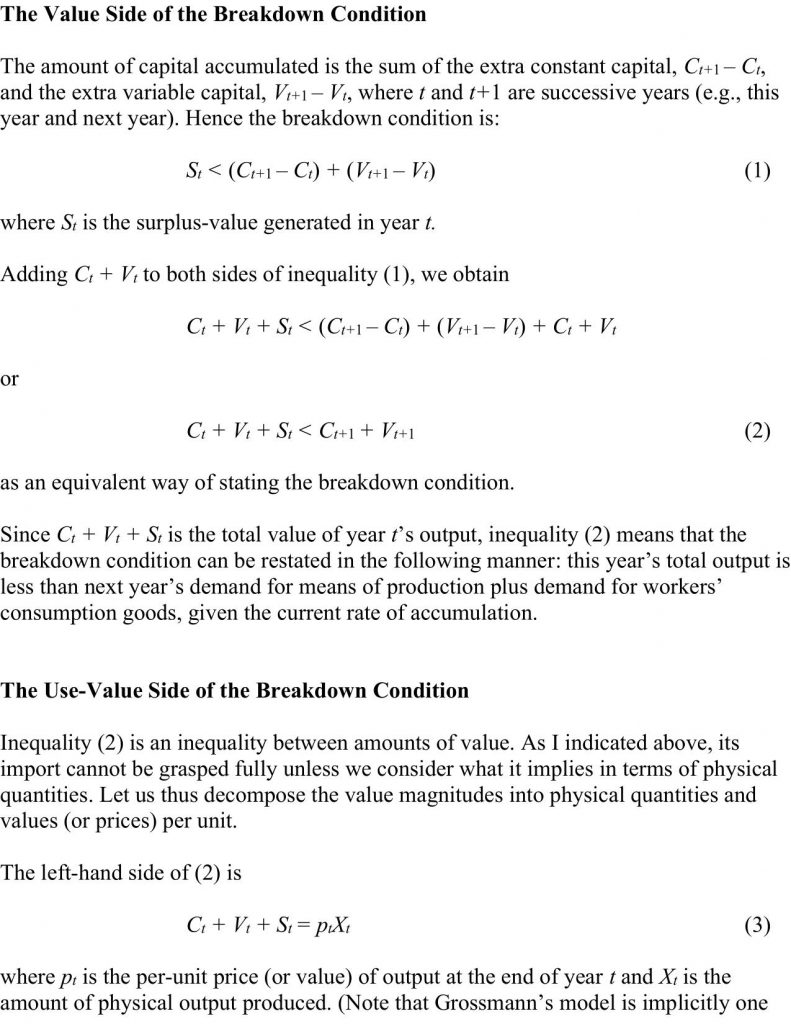
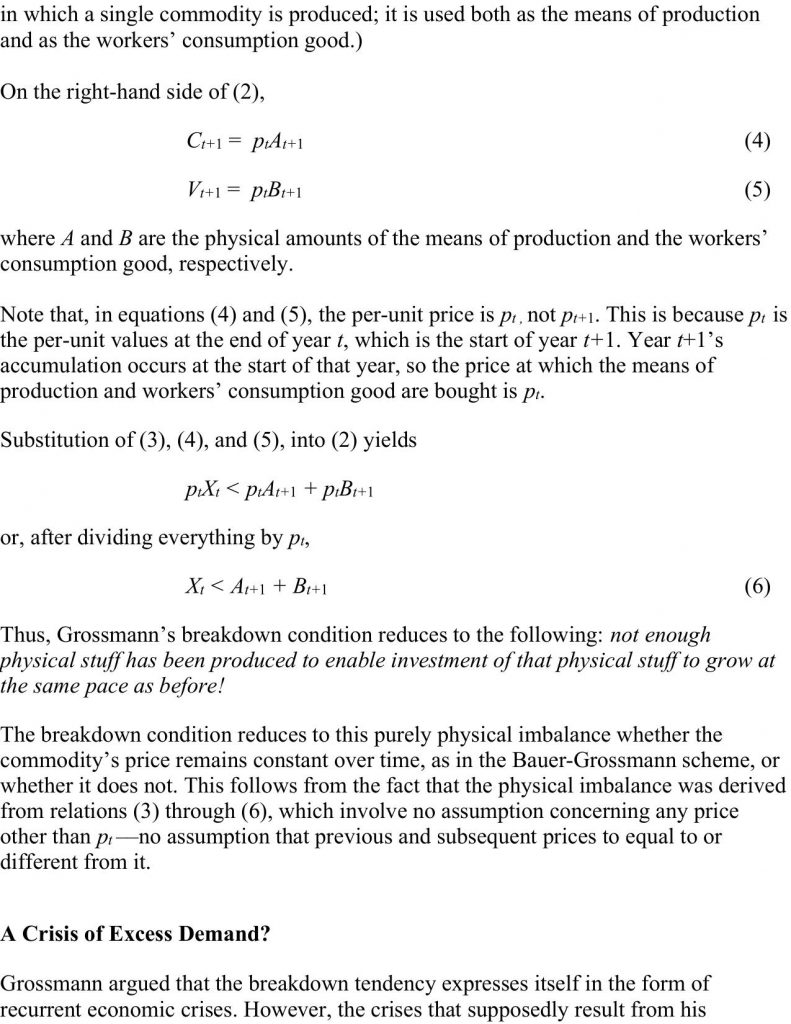
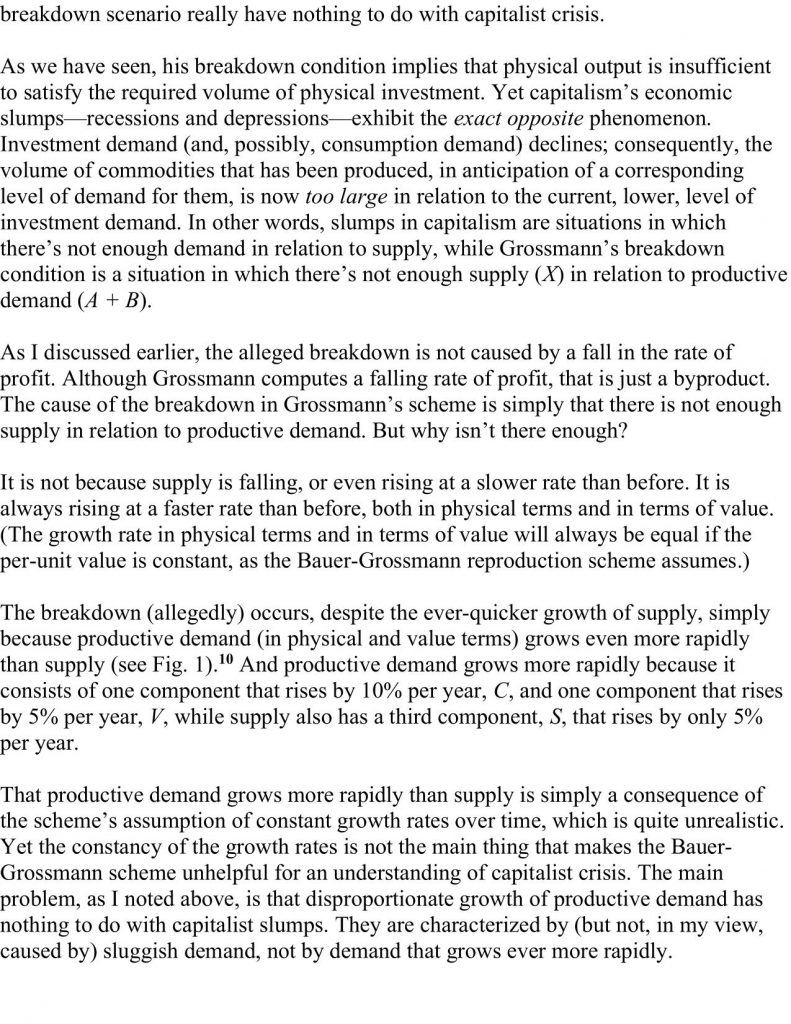
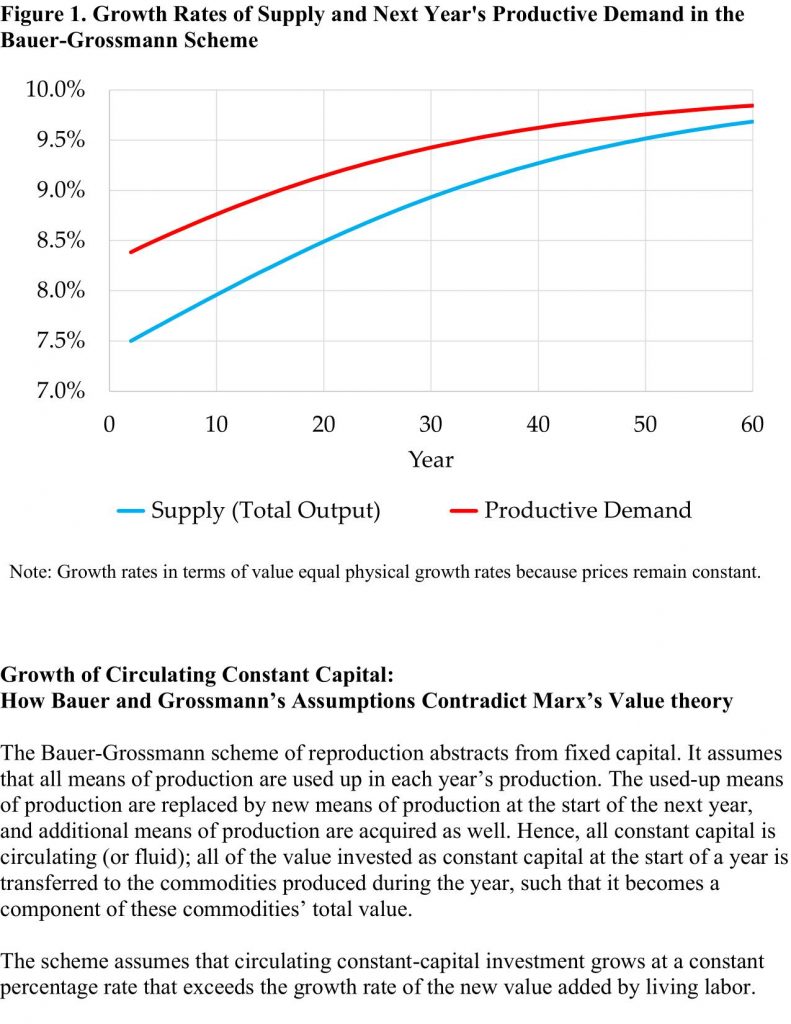
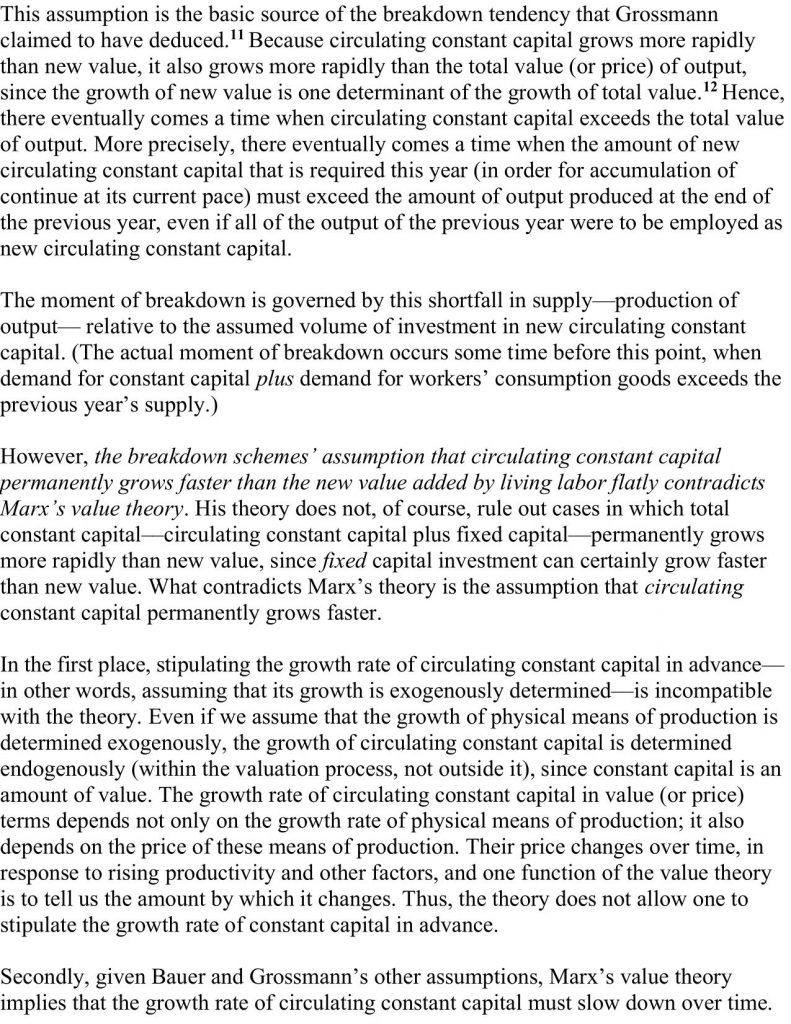
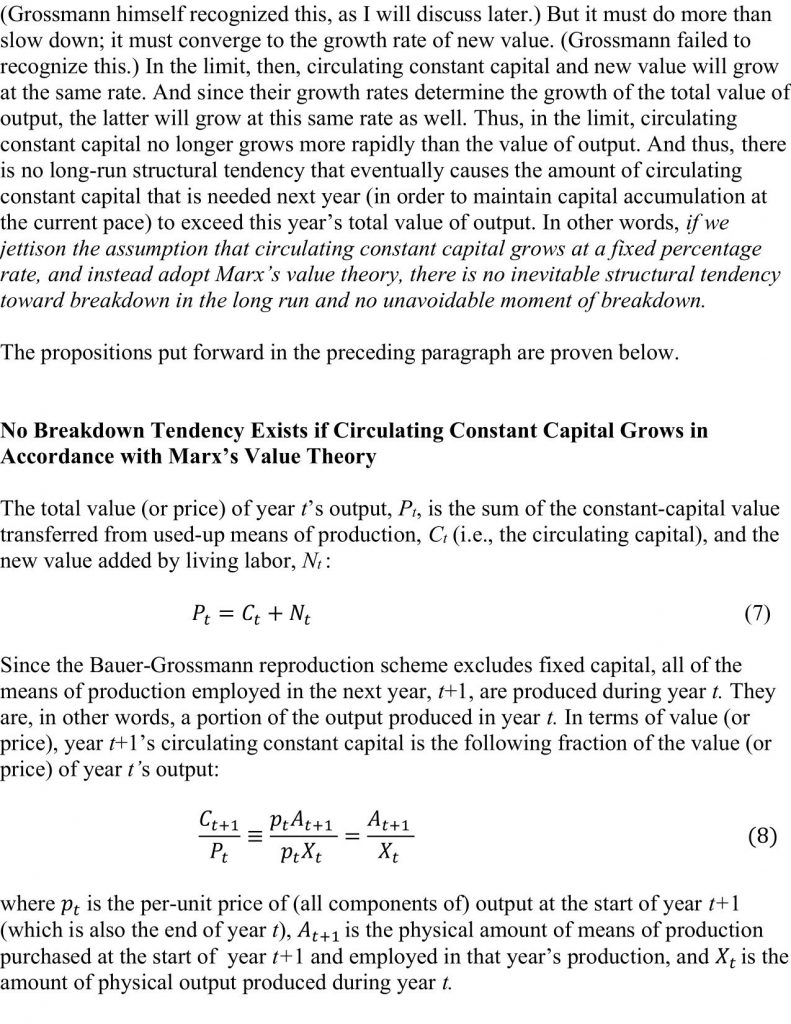
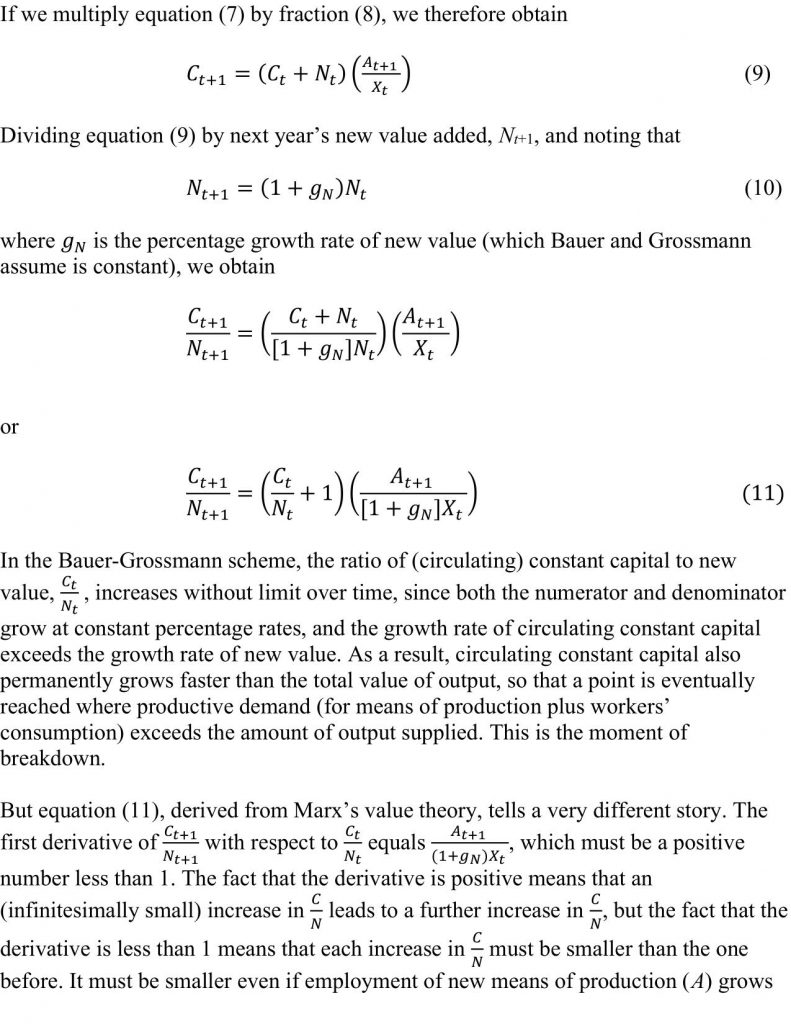
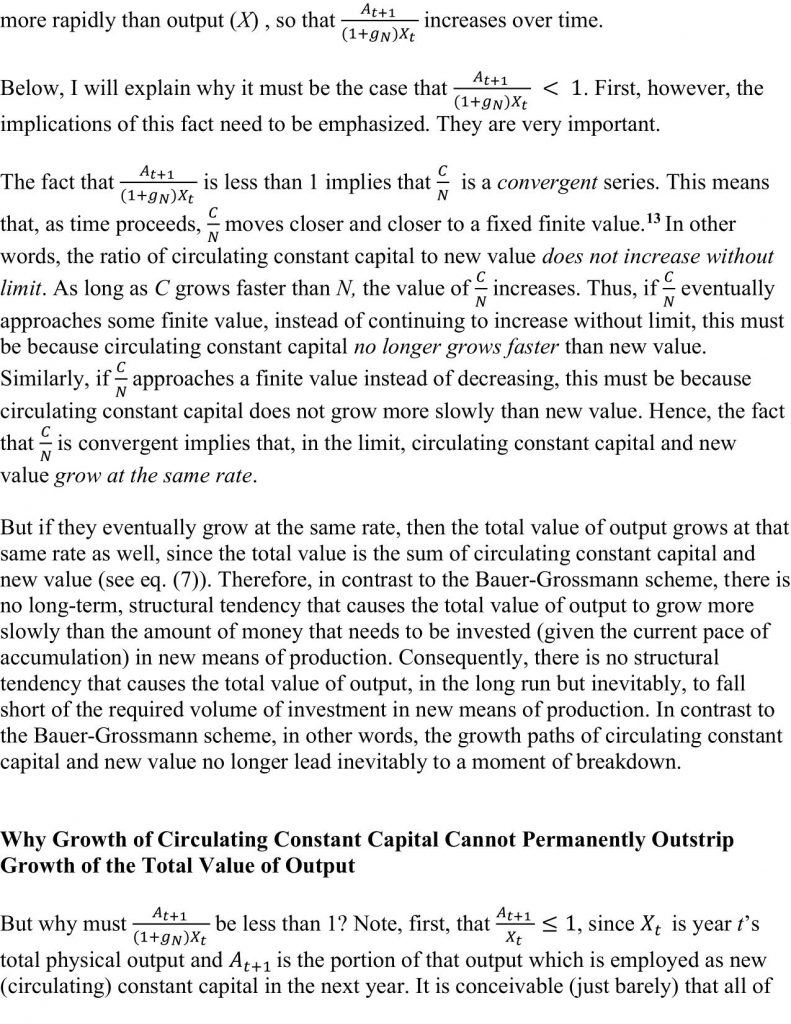
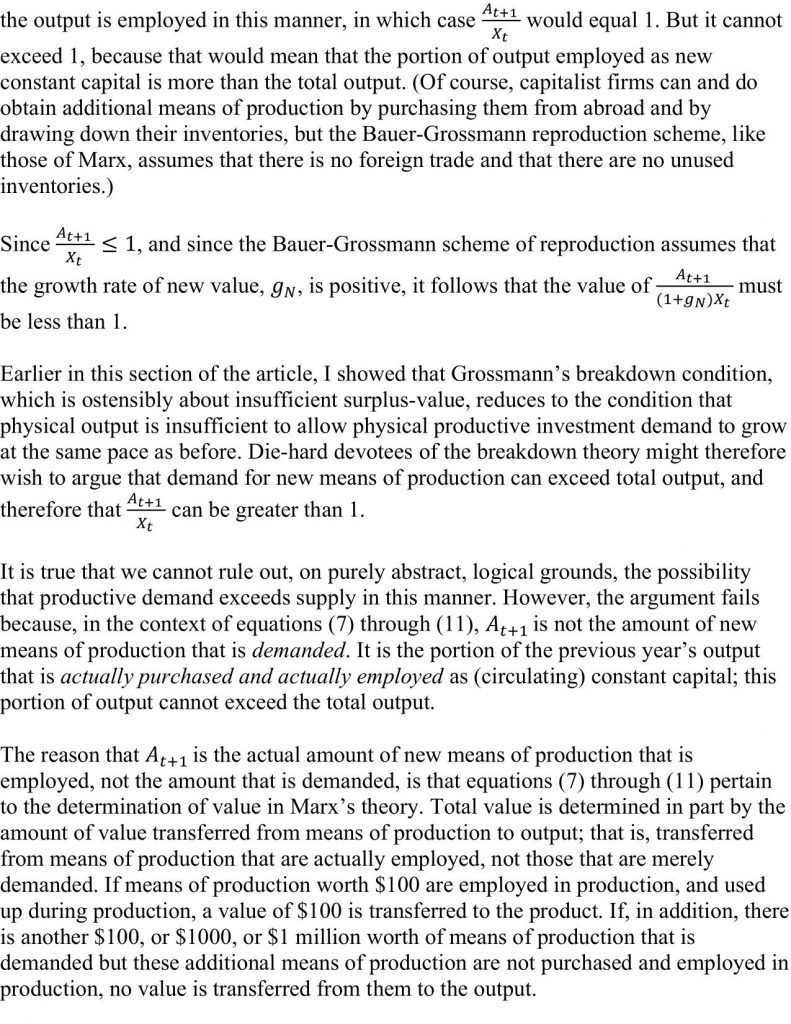
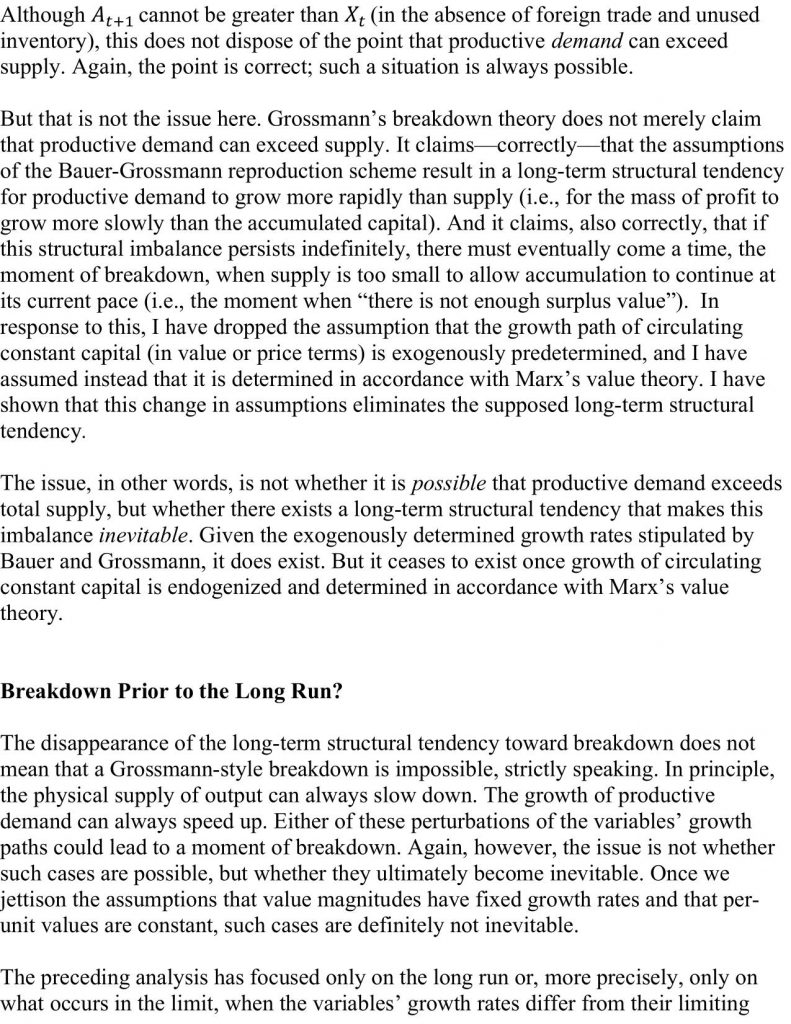

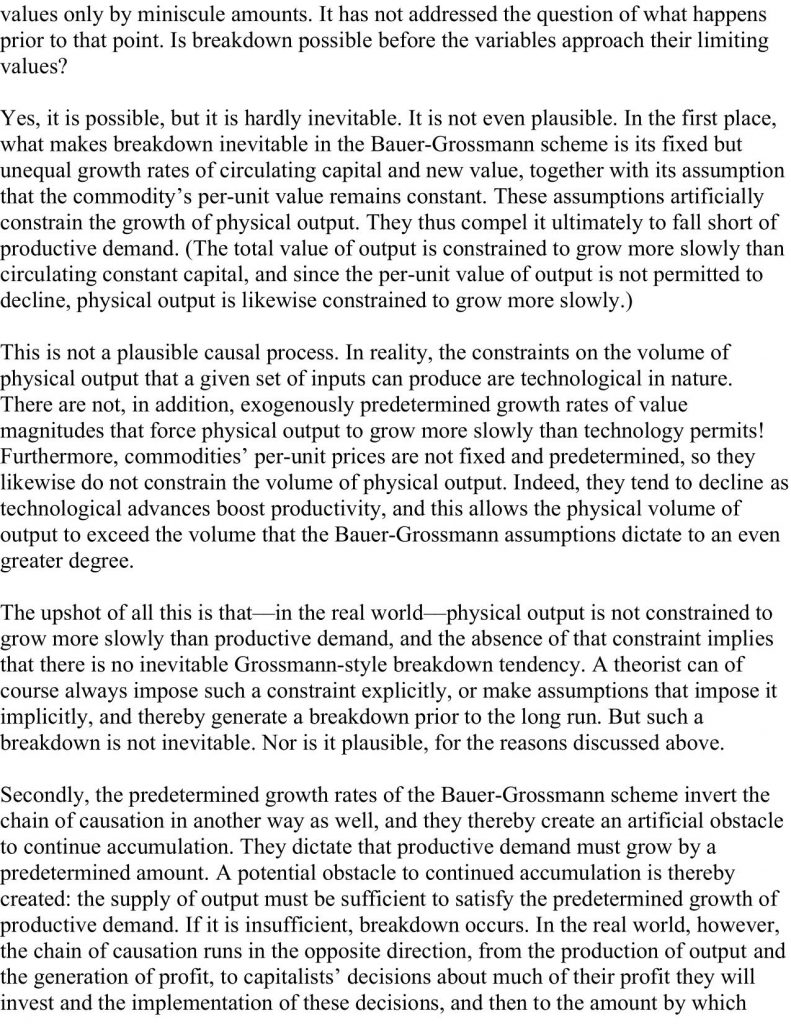
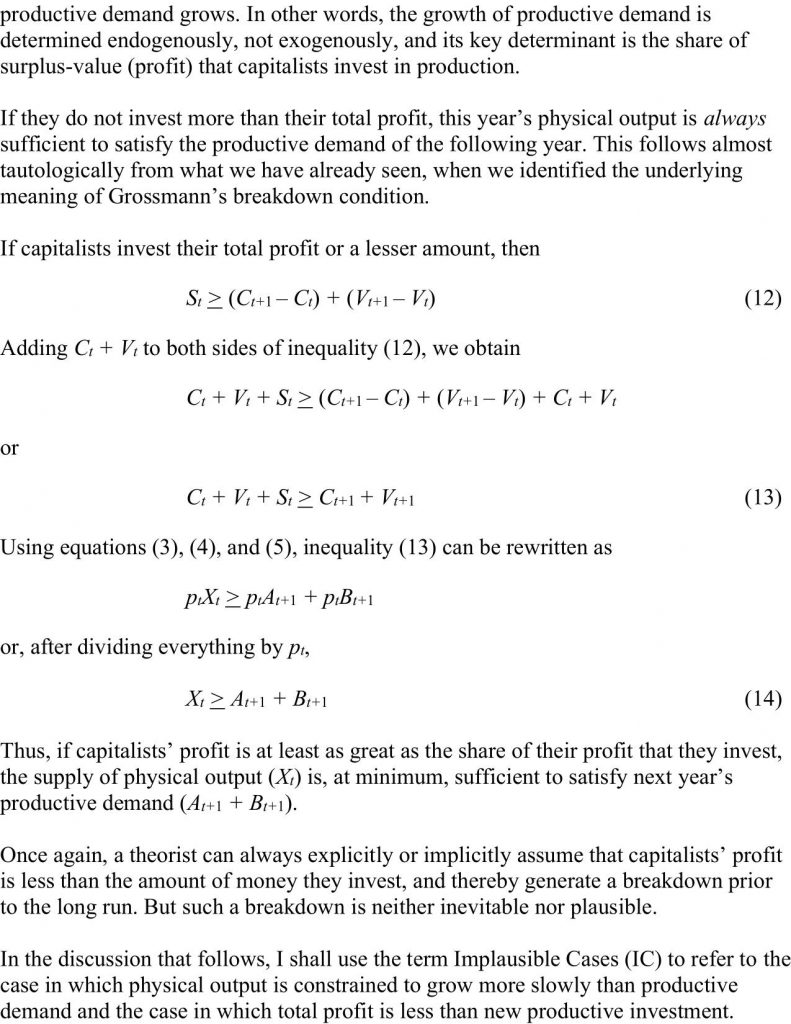
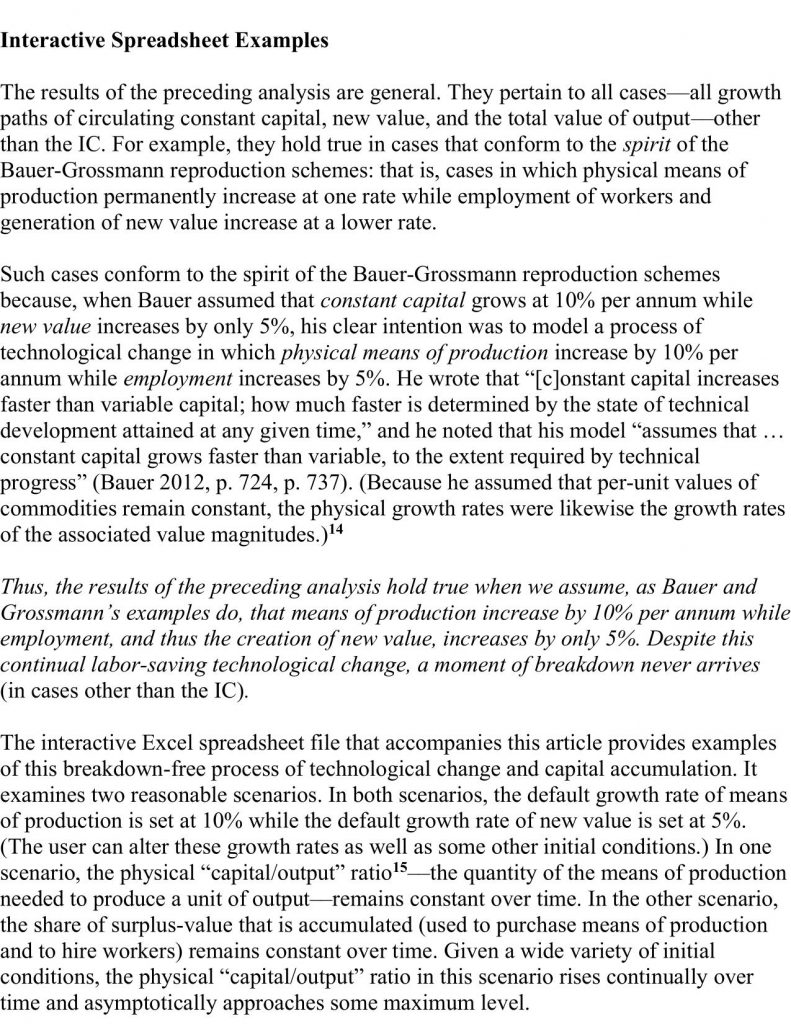
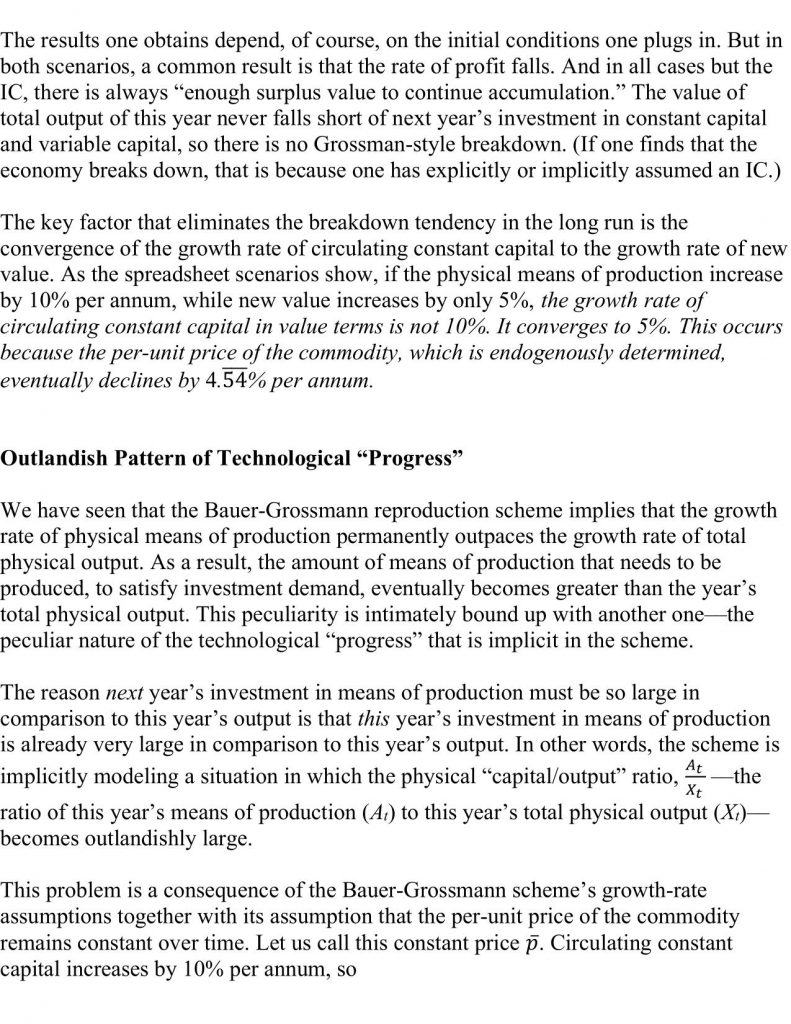

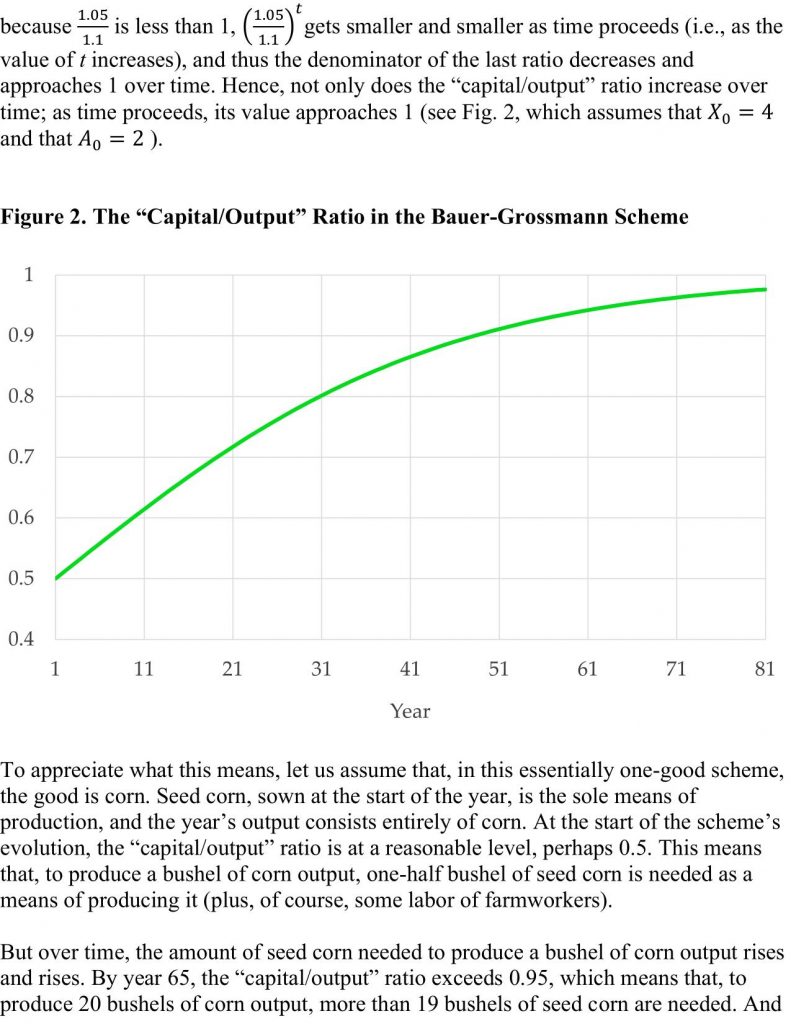
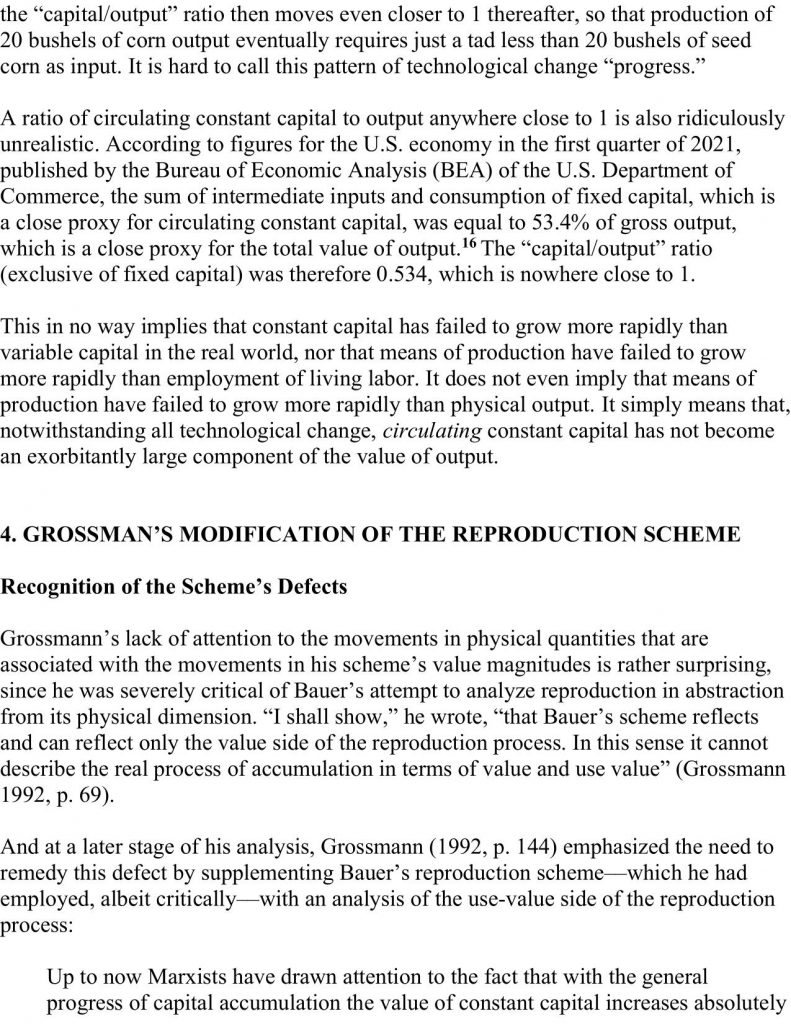
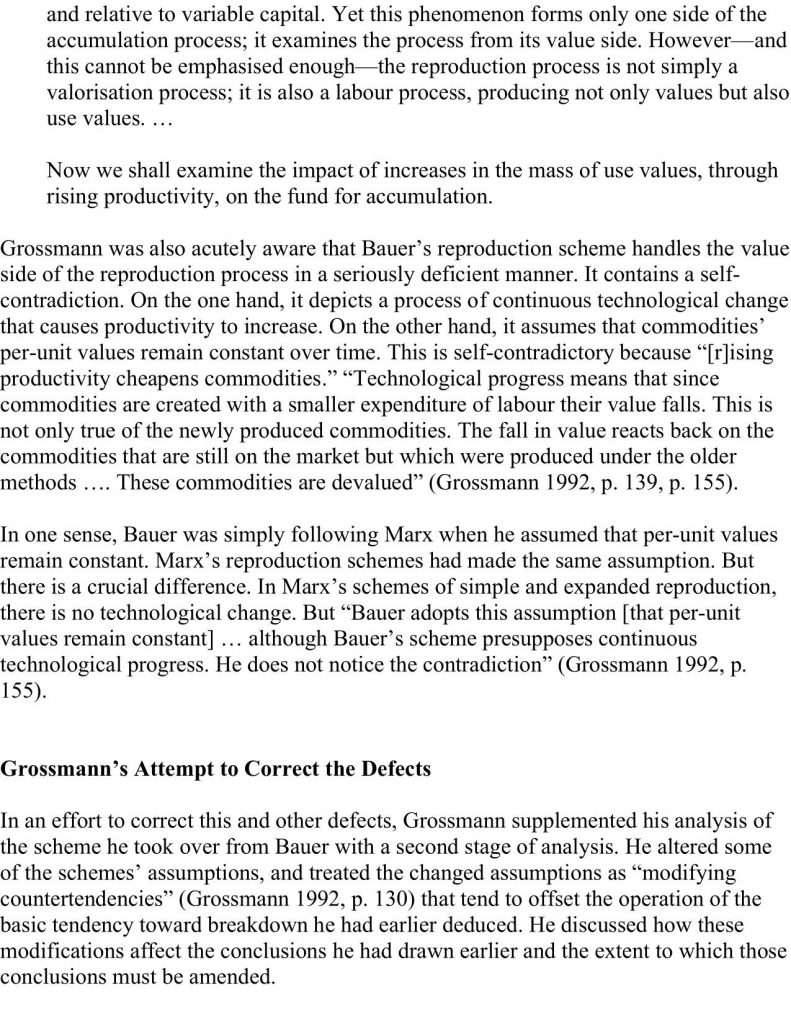
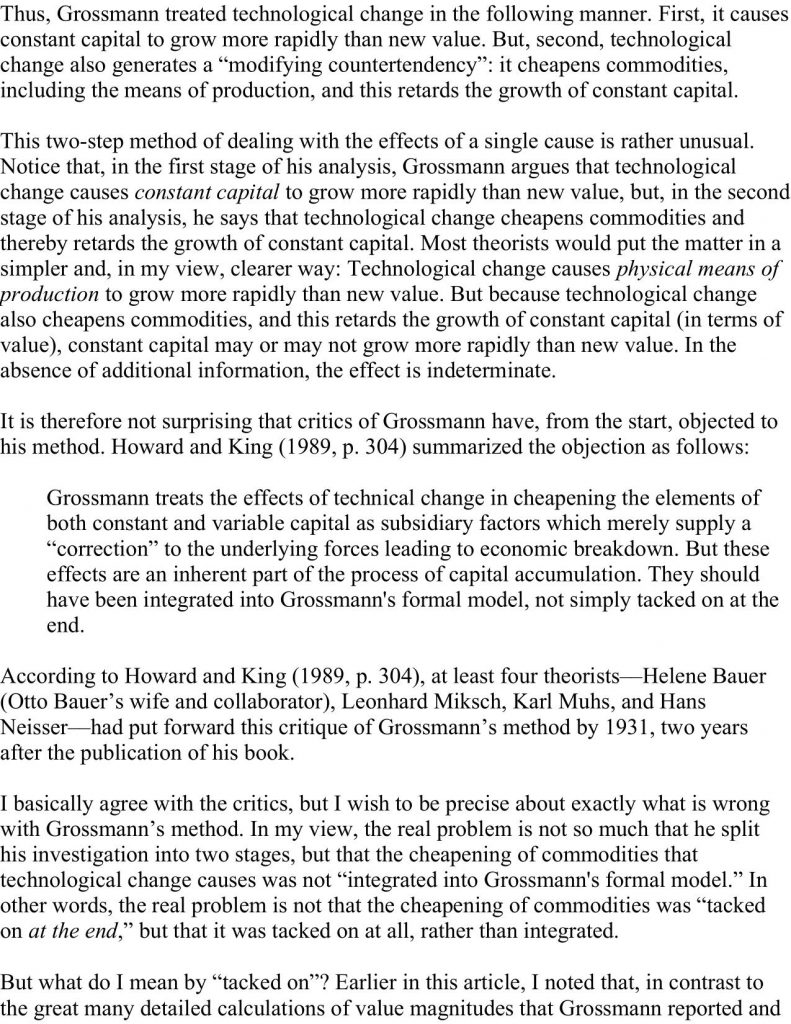
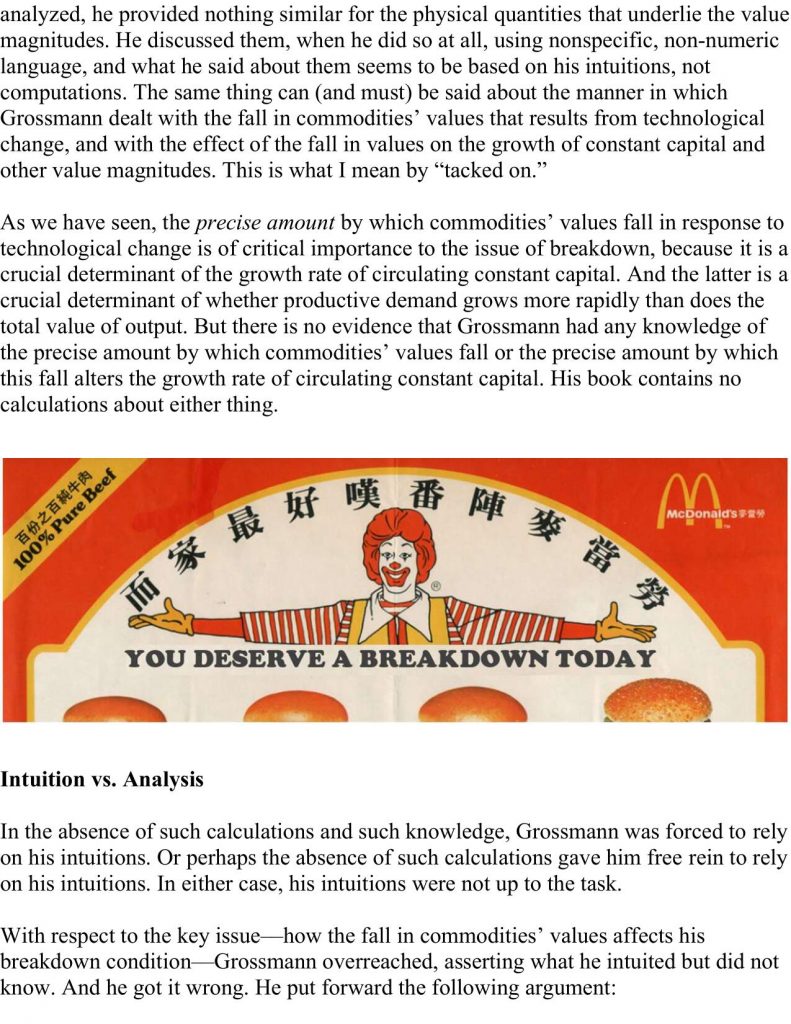
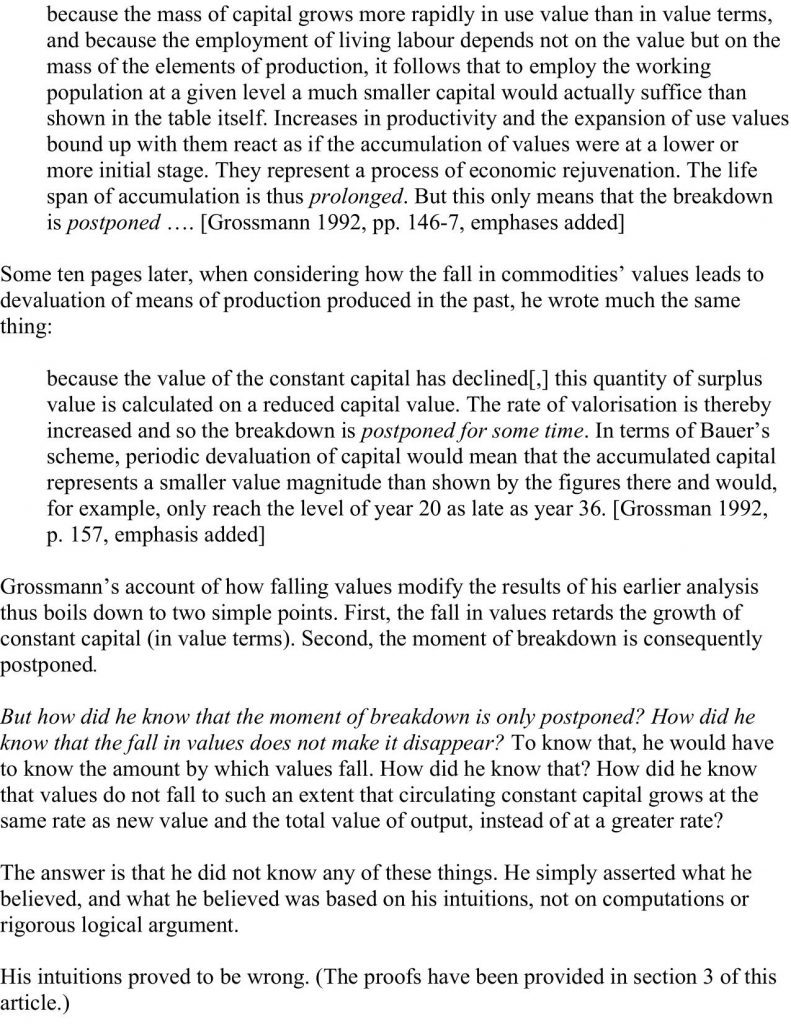
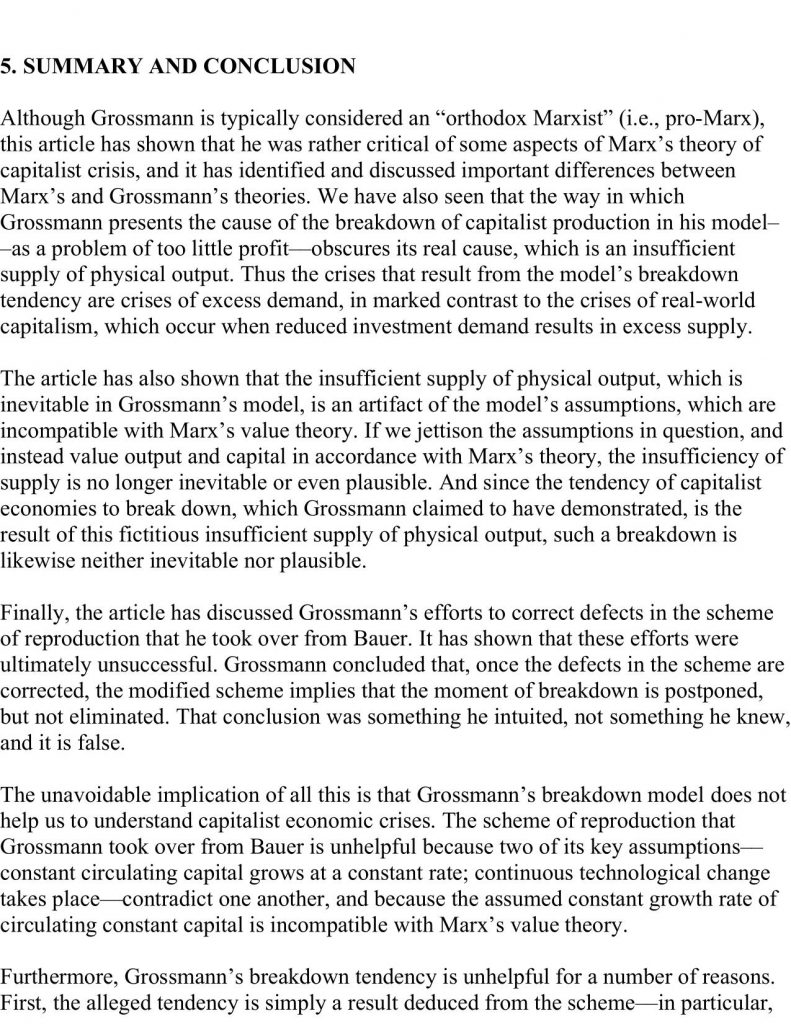

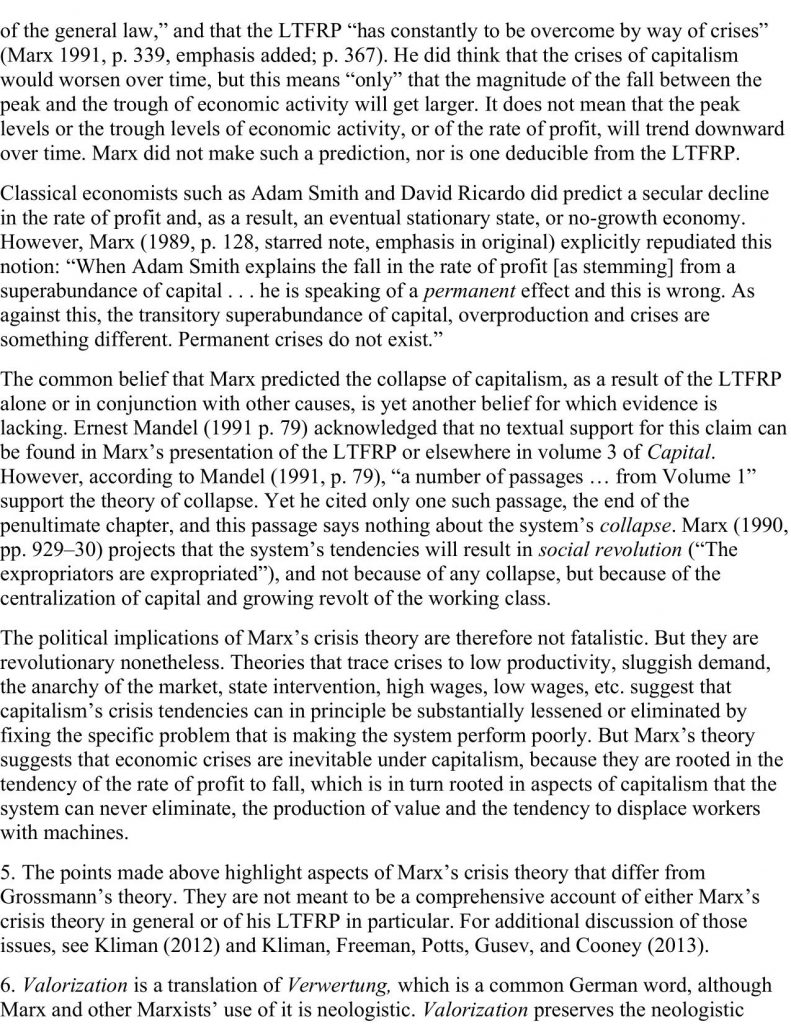
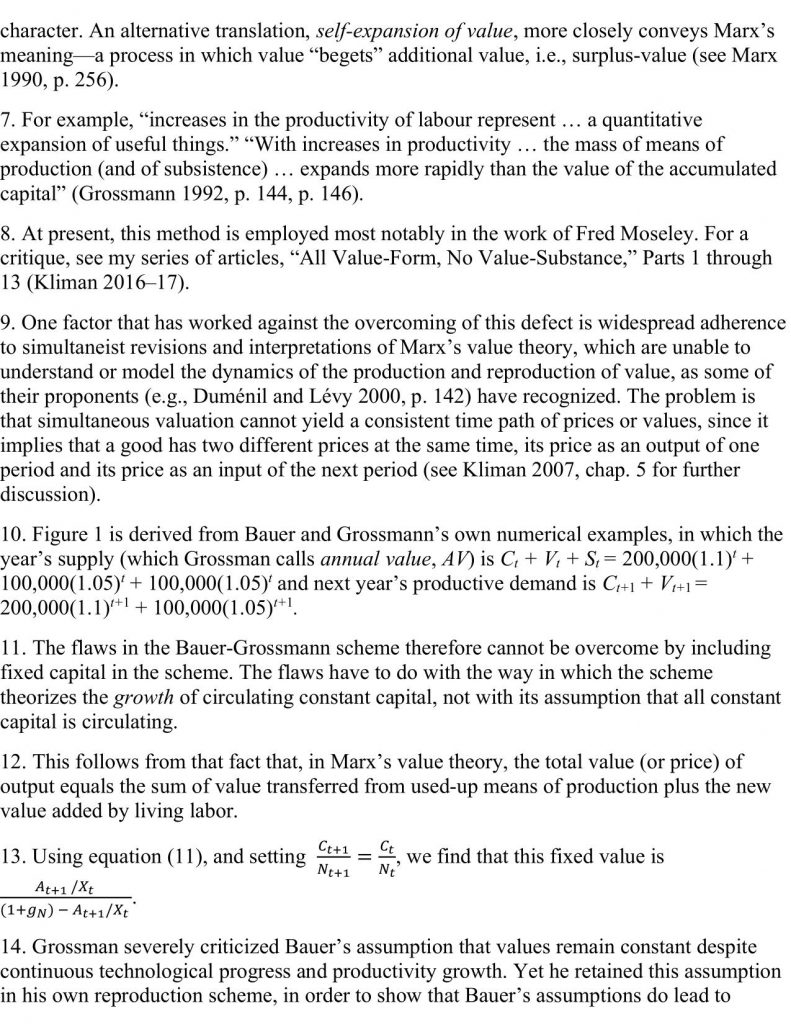
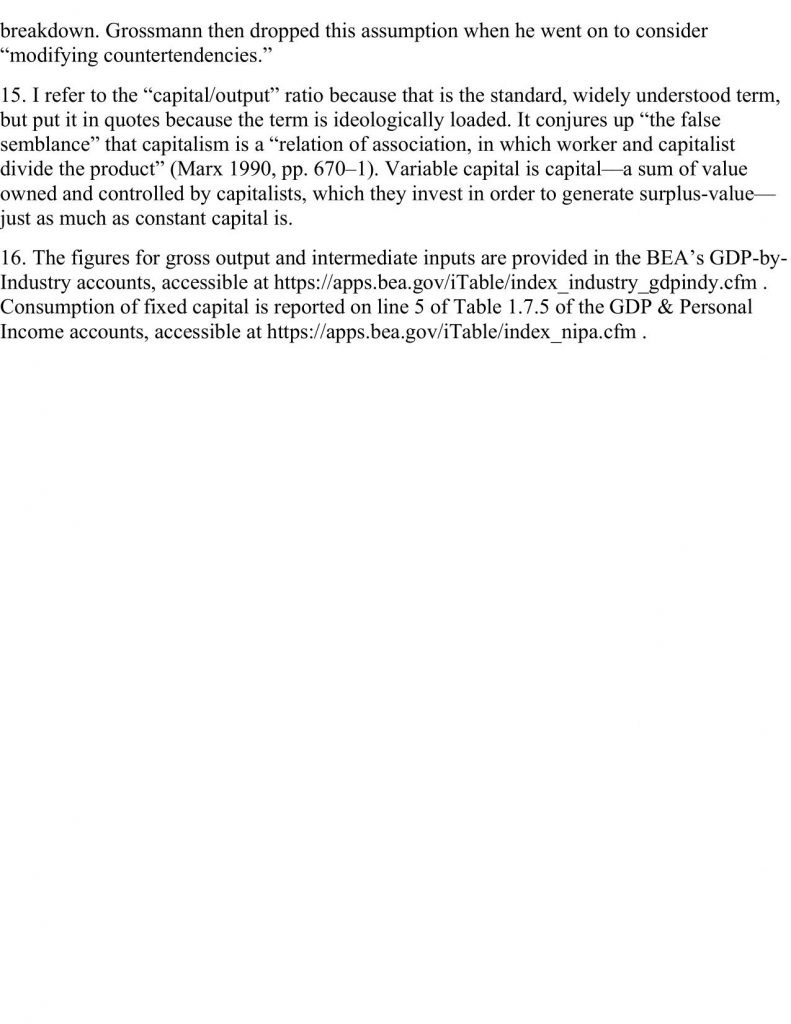

Thanks for this measured critique; beyond the various technical problems with Grossman’s work that you discuss here, it seems to me that his analysis depends on a gratuitous psychological/political assumption about capitalist behaviour — that they will give up the game merely because their personal revenue disappears.
But being a capitalist is a valuable social privilege, one worth making sacrifices to retain. And of course the capitalists do not in fact have to make personal sacrifices — they can extort resources from society at the point of a gun, i.e. by instituting a fascist regime.
Given Grossman’s location in space and time, failure to consider this seems a rather startling oversight.
MHI is posting the following comment on behalf of Peter Jones:
I agree that Grossman’s model does not demonstrate any necessity or likelihood of breakdown, largely for the same reasons you have given (see Jones 2021, The Falling Rate of Profit and the Great Recession, where I discuss Grossman’s model briefly).
However, I think he and Marx were working with powerful intuitions when they hypothesised the possibility for the mass of profits to fall, and this potentially triggering crisis.
What Marx seems to be imagining is a situation where the decline in the rate of profit has gone so far that despite accumulation of capital continuing, the mass of surplus value declines. He seems to have thought about the following very basic decomposition of the growth in surplus value (S):
S = ROP / K
And decided that the decline in the ROP (S / K) might be a bigger influence than the growth in the capital stock (K).
As Grossman points out, Marx does not say how this would lead directly to a crisis. Grossman’s idea was that it wouldn’t leave the capitalists enough to consume after allocating enough value to maintain a constant rate of growth. But Grossman’s assumption of a constant rate of growth is just specified exogenously, so this aspect of his schema cannot demonstrate the necessity of breakdown, as Kliman argues.
But is there potentially a plausible theory of crisis that can be salvaged from Marx’s hypothetical absolute over-accumulation of capital?
A crucial manifestation of crises is in fact a decline in investment. We tend to think of this as due to a lack of demand for investment caused by a crisis in confidence, that is plausibly related to a fall in the underlying rate of profit. But what if a decline in the mass of surplus value was a link in the chain? Investors tend not to panic if the underlying return on capital has declined, as long as earnings are still growing. (Potentially because as long as earnings after interest and taxes are growing, the business is not destroying capital.) But when earnings after interest, taxes, amortisation and depreciation go significantly backwards, people start to panic. Why would you hand your investment to a business that at the margin looks to be destroying capital? You are better off in cash or bonds.
So the question I would like to answer is, can we develop a plausible model where the mass of surplus value does actually decline, due to the effect of the declining rate of profit being stronger than the growth in the capital stock?
Empirically, a decline in the mass of profits probably is correlated with crises. This could just be due to a crisis of confidence leading to a plunge in investment, hence insufficient aggregate demand, hence a decline in profits (which still may be connected to a fall in the ROP). However, it seems to me at least plausible that the chain of causation goes the other way: there is first a decline in the mass of profits, then a sharp drop in actual investment caused by the crisis in confidence.
With some quick modifications to your spreadsheet versions of Grossman’s model I ‘produced’ a decline in the mass of profits due to labour saving technical change and a declining rate of profit (https://mega.nz/file/3VxV0SLS#aB-cA43UrLFuXp7IhkEiA2i-eLk9KZpGxUSiaBD1Xnc). I think the assumptions are quite abstract, it would be better to build up from ‘microfoundations’ where capitalists have an incentive to introduce the technical change. But given you and others have given counter-examples to the Okishio Theorem this should be possible.
I agree with the political and philosophical points about fatalism.
Hi Peter,
I don’t understand why you weren’t able to post your comment. You evidently wrote it when you produced your spreadsheet, which includes an Oct. 30 date. But I’ve only seen it now.
As you know, I think “Marx’s hypothetical absolute over-accumulation of capital” is a misleading formulation. He rejected the idea that overaccumulation is absolute, as I discussed in my article. I, too, think that this idea is a red herring that has held back and messed up crisis theory.
I’m glad that we agree that the task is to produce a theory that is not only formally possible, in the abstract, but one that is plausible (and one that withstands attempts at empirical falsification). The biggest problem with your spreadsheet modification that produces “a decline in the mass of profits due to labour saving technical change and a declining rate of profit” is that it isn’t plausible. The underlying physical scenario isn’t even physically possible.
Please see my extension of your computations and my formulation of a physically possible and plausible alternative here: https://marxisthumanistinitiative.org/wp-content/uploads/2021/11/Peter-Jones-Reproduction-Scheme-Made-Plausible.-11.23.21.xlsx
In your example, living labor (employment) and new value added start to decline in year 14, and they become negative starting around year 41, which isn’t physically possible. Shortly after that, the “capital/output” ratio rises above 1 and investment in means of production exceeds total physical output.
I doubt that this is what you intended to produce. More likely, you were trying to produce an example based on an intuition concerning the movement of value magnitudes, but without regard to the economy’s physical relations. You stipulated a time path of the per-unit price that seems to make the intuition “work”–if we disregard the fact that this causes the associated physical quantities not to “work.”
I think it’s much better to begin with a scenario that’s physically possible and plausible, and then determine the per-unit price endogenously (in accordance with Marx’s value theory). This is what I’ve done in a new tab of the spreadsheet. Means of production grow at a 10% rate; living labor and new value grow at a 5% rate. As in your example, unproductive spending equals 10% of the total value of output, and 25% of the surplus-value that’s left over after unproductive spending is accumulated. There’s no breakdown, no crisis, no falling profits. (Given this particular share of surplus-value that’s accumulated, 25%, there isn’t even any fall in the rate of profit–all variables’ growth rates turn out to be constant.)
As for the actual immediate causes of crises and slumps, I think that there are sometimes crises of confidence. There are also problems of excessive debt, speculation, and fraud. And regular downturns seem to be driven in part by the labor supply vs. labor demand dynamics that Marx described in vol. 1 of Capital and that Goodwin formalized: Booms lead to rising employment and rising wages + benefits, which reduce the rate of surplus-value, which in turn leads to a relative decline in investment and then recession.
Hi Andrew,
In my modified model there is a crisis in year 9. The model doesn’t go beyond that year. The extensions to later years are yours. I’d appreciate if you’d make this clear to your readers.
Once there is a crisis, it’s implausible to assume the same conditions hold. This is why I ended my model in year 9.
The impossible outcomes you have seem to have produced are a product of your decision to implausibly assume the crisis does nothing to affect accumulation. I’m not ruling out other implausibilities in the model; indeed, for something so abstract this is even likely. The point was to show that it’s relatively easy to throw together a range of assumptions that produce a decline in the mass of profits.
Note that, if you insist on a crisis changing none of the original assumptions, growth rates and trends, you may well be insisting on a model that cannot produce a crisis by definition. A crisis is by definition a point of discontinuity.
I also think you strongly overstate the case when you say Marx rejected the possibility of an absolute overaccumulation of capital. It’s clear he considered it as a hypothetical case, and then considered other possibilities and tendencies, such as the effect of foreign flows. If an ‘absolute overaccumulation’ means capitalism can never recover, I think this is an example of the fatalism you rightly criticise.
But in the more technical way Marx was looking at the issue it makes sense. I take it you accept that declines in the mass of profit (‘absolute’ declines) do in fact happen. They are definitely in national accounts data in some years on a broad range of definitions of profit.
I think it’s plausible that the mass of profits could decline for reasons other than a crisis itself, causing a crisis (rather than being an effect), which are the potentially most interesting cases. For example, if there was a significant labour saving technical change affecting many workplaces, employment could decline in absolute terms. So at an unchanged rate of surplus value the mass of profits would fall, which could trigger a crisis. Other possibilities include a decline in the rate of surplus value, or a change in foreign trade conditions.
Peter,
I don’t know how you can possibly fail to recognize that Marx was rejecting the notion that overaccumulation of capital is absolute (i.e., the notion that there comes a time when additional investment yields no additional profit) when he stated that “If capital is sent abroad, this is not because it absolutely could not be employed at home. It is rather because it can be employed abroad at a higher rate of profit” (see my article, above, for citation). How is this statement–that capital invested in the domestic economy does yield additional profit–compatible with the notion that capital invested in the domestic economy doesn’t yield additional profit?
I didn’t create the implausibility in your model. The implausibility is built in. It’s evident even in the short window you choose to showcase–growth rates of everything are declining from the get-go, for no good reason. My extension of the calculations beyond the short window you choose to showcase just reveals more clearly how implausible the model is–from the very beginning.
The most implausible thing you do is arbitrarily impose growth rates of value magnitudes, and arbitrarily impose the rate of decline in the per-unit price, and then force the physical quantities to “fit” these arbitrary assumptions. That’s just not how the world works, as I explained in my article.
Even worse, you impose a growth condition on value magnitudes that is simply impossible–constant capital increases, as a share of total capital, without limit. So it eventually becomes more than 100% of total capital. What’s the warrant for that?
As a result of constant capital exceeding total capital, variable capital becomes negative, as do the amount of living labor that workers perform, and the amount of new value their labor creates, and the amount of surplus-value it creates. And the associated physical process is impossible as well–eventually, more than a bushel of seed corn is needed as input to produce a bushel of corn output, and, eventually, new investment in seed corn exceeds the amount of corn that has been produced.
These lovely features of your model are all built in from the start. It is THEY that produce the crisis and breakdown. I showed this in the spreadsheet I linked to in my 1st response. I used your own assumptions that 10% of total value is spent unproductively and 25% of profit-after-unproductive-spending is accumulated. But I assumed a plausible physical process (means of production grow at 10% p.a.; living labor grows at 5% p.a.) and endogenous determination of the per-unit price. As a result, there’s no crisis, no breakdown.
It follows necessarily that your crisis and breakdown are not due to unproductive spending or the share of profit that’s accumulated; they are due to the impossible process of determination of physical variables that you assume from the get-go and the associated unlimited growth of constant capital as a share of total capital that you also assume from the get-go.
But I guess that, if one is willing to believe in absolute overaccumulation, one might as well believe in some economic law imposed on capitalists that compels their investment in constant capital to rise without limit as a share of their total capital!
Hi Andrew,
There is a good reason the per unit values decline. That’s labour saving technical change, which Marx was assuming. And that’s the same reason the ratio of constant capital to total capital increases. There is nothing physically impossible about these trends that you have identified or that I can see, though you have asserted this. When there is labour saving technical change, values per physical unit really do decline.
The purpose of this abstract model is to demonstrate the possibility that labour saving technical change can lead to a crisis. It doesn’t demonstrate that all labour saving technical change must lead to a crisis under all conditions, and never purported to.
Again, there is no basis for extending the model beyond the 9th year with the same assumptions. In that year, there is a crisis because additional capital no longer yields additional profit. To extend the model, you would need to make some plausible assumption about how that crisis affects the rate of technical change and the rate of accumulation, which you haven’t done.
Again I want to draw attention to the fact that, empirically, in some years the mass of profit actually does decline, and that often this coincides with crises. This is an important point your response does not mention. The beginning of wisdom is surely to acknowledge that this can and does happen, and isn’t somehow ruled out a priori.
All the model is trying to show is that there could be a chain of causation from labour saving technical change to a decline in the mass of profits to a crisis. But there could also be a chain of causation the other way, from a crisis of investor confidence to reduced capacity utilisation to a lower mass of profits. Both are potentially interesting cases, but only the second is widely recognised as a potential cause of crisis.
All the model shows is that there is a set of initial conditions and trends that could cause a crisis in this way. The model asserts nothing about whether this set of conditions has to happen and could never establish that, because no model can do this.
As I mentioned, it would be better show how microfoundations could lead capitalists to want to introduce these technical changes leading to a crisis.
All the Marx quote you have relied on is saying is that an absolute over-accumulation of capital is not necessary to explain the existence of foreign investment, which is more likely to be due to profit rate differentials. It says nothing about Marx’s view of the possibility or impossibility of an absolute over-accumulation of capital, and your statement is the first time I’ve come across your interpretation. I don’t think Marx thought that the ‘absolute’ over-accumulation of capital was some fixed point that capitalism could reach and then would then fall over because it couldn’t generate more profits. But a failure to produce additional profit across the system as a whole in a year when there is investment in the capital stock is a potential trigger of a crisis.
Marx thought crises tended to devalue and potentially physically destroy capital, allowing for the rate of profit to recover, rather than being some final end point for the system. I think the idea of a final breakdown of capitalism is really what you are arguing against. If so, it would make more sense to oppose just that, rather than throw out one of the more powerful hypotheses about the dynamics of accumulation that Marx made.
That’s the fundamental issue here. Do we throw out a hypothesis about a cause of crises a priori, a la the Okishio Theorem with a falling rate of profit explanation? Your analysis does not give us a reason to do this.